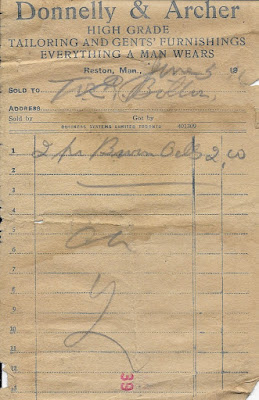After many weeks of highlighting businesses and former businesses in Reston, my next focus will be on recreational facilities, starting at the rink.
In today's age where most recreation complexes are owned and maintained by municipal governments, it is interesting to think of the days when they were privately owned. I suppose municipalities were busy with necessary pioneer needs - roads, health and education. Recreation was not their concern so it was up to users to build and maintain the facilities. Natural ice surfaces like the Pipestone Creek and sloughs would have been the first spots used for skating, curling and even hockey.
The Trails Along the Pipestone (1981) tells that the first location of a curling rink in Reston was on First Avenue just west of the future home of Wm Lockhart & Sons Garage. It was built in 1897 and was a ring of wood walls. The canvas top meant as much snow did not accumulate on the ice and at 46 x 140 feet it was lit with coal oil lanterns. Rocks for curling were privately owned or made of wood with lead filling for weight. Warm coats, often buffalo and flat caps looked to be a part of the needed equipment. It was a men only sport in these days, probably until the 1920's or 30's.
 |
In 1905, there was a desire for something better so a group of interested locals bought shares in an enterprise called Reston Rink Co. They built the rink pictured at the top of this post on the west side of Second Street between First and Second Avenue. The Fire Underwriters' Map from 1928 shows it below. It was used for almost 50 years and would have been a welcome diversion during both wars, the depression and a popular gathering spot for all ages.

In 1954, community leaders like A.E. Smith and Dr. A. B. Chapman worked to get a new rink going at the present location on the west end of Fourth Avenue. I’m unsure of who was behind the financial investment but no doubt it was the community that held fundraisers and pledged funds to make it happen. Dr. Chapman was given the honour of throwing the first stone at the opening ceremony. It had 3 sheets of curling ice and a skating surface. It was also one of the first built with Dring Rafters. Dring Laminated Structures Incorporated was a Boissevain company that pioneered the lamination progress to make beams. Instead of nailing multiple layers together for strength, they began gluing them. Brothers George and Arthur Dring emigrated from England in 1922 and used their carpentry skills to open the company. At the height of the business in Boissevain, it employed 85 people. The company still exists and is known as Western Archrib.
Curling, hockey and pleasure skating were enjoyed by many here for almost a decade. Figure Skating Ice Shows were held many years and professional figure skater Vern Glass is remembered as creating wonderful performances. Amazing costumes and backgrounds were part of his shows and the rink was packed with family and fans on Ice Show day. Vern came to Reston as the caretaker and projectionist for the theatre from opening in 1948 until 1960.
As a result of the combination of the flammable glue in the rafters and faulty wiring, a disastrous fire occurred on November 23, 1963. Apparently, all that was saved were two curling rocks. What a shame to lose all the irreplaceable trophies, uniforms, equipment, backdrops and costumes that were stored there!
 |
| Fundraising Shares issued to Bill Lockhart to his garage W. Lockhart & Sons in 1964 |
In early 1964, work began on a new facility and it was opened that fall. What a hub of building the community of Reston was in during these years! In a short few months, people were justifiably proud of the 4 sheets of curling ice, skating ice, 73 theatre seats in the waiting room and new Public Address system. Charlie Cook had the honour of cutting the ribbon to open the rink. In 1967, a cement floor was poured for the curling side to allow for community gathering space and artificial ice installation. The skating side later became artificial ice as well. The main entrance was on the south side - stairs went down to basement dressing rooms or up to waiting room. An elevator was later installed for accessibility.

The Reston RecPlex has been home to the Fun Fair, fair dances, socials, wedding dances, grads, memorial services, reunions, pancake breakfasts and so much more for the entire community. In the early 2000's, four main floor dressing rooms, a curling room, fitness centre and entrance were built to the east. Pews were installed for skating ice fans in the waiting room and updates to the canteen kitchen were made as well. The wide sills under the windows (with the pie plate ashtrays!) have been replaced with full height plexiglass to give the fans a view of the action. The curling room was named the Caldwell Lounge in honour of Clyde Caldwell who was an builder of community in Reston for many years. the rink continues to thrive under the care of a volunteer board who take on fundraising and set policy for the user groups to follow. In the years to come, I hope that many more skaters will take their first solo glides and score their first goal on the ice and make their first take out on the curling side.

































